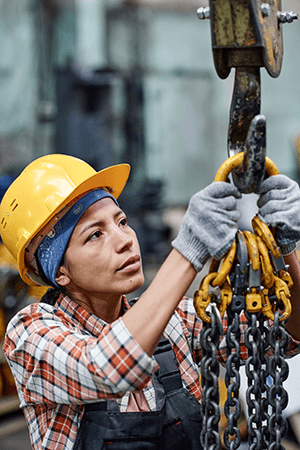Women in the Safety Industry

Breaking Barriers: Women Shatter Stereotypes in Health and Safety
The lack of gender diversity is an issue for many industries, and changing this has been a challenge. A group of safety professionals distributed a survey in August 2023 to women in the Health and Safety industry (HSI) and Environment, Health and Safety (EHS) databases to gauge areas that needed improvement and received 865 responses to the 14 questions. On top of the information gathered from the survey, here are some statistics about the U.S. workforce:
- 47% women
- 25-29% of women are in safety professions
- 22% of women with a safety certification
 What Challenges Do Women Face in the Health and Safety Industry?
What Challenges Do Women Face in the Health and Safety Industry?
Many women who enter the safety industry, didn’t initially set out to be in this industry. 24 percent of women have been in the safety industry on average 2-5 years. According to the HSI survey, there are a range of challenges many women face in the safety industry.
1. Pay Equity—Women are paid 83.7% of what men are paid for the same position.2. Harassment— Harassment comes in three forms: verbal/written, visual, and physical. Women often face all three forms in the workplace. According to survey data gathered by the Centers for Disease Control (CDC) and an article written by Fierce Healthcare:
- 6.4% of women reported workplace harassment in 2018
- Women reporting workplace harassment doubled to 13.4% by 2022
- Women are 5 times more likely to report harassment due to impact on their mental health
- Sending offensive jokes or graphics through email
- Requesting dates or sexual favors in person or through text
- Making derogatory comments about someone’s disability, gender, sexual orientation, or age
- Wearing clothing with offensive or vulgar language
- Displaying posters or pictures of a sexual nature
- Showing other people sexually suggestive text messages or emails
- 5,333 fatal workplace injuries occurred in the United States in 2019
- 761 of the fatal workplace injuries were cases of intentional injury by another person.
- 8% of women have experienced some form of harassment or workplace violence
One in five people have experienced violence in the form of physical, psychological, or sexual harassment at work. Sadly, many of these incidents are not reported. Research studies identified factors that may increase the risk of violence for some workers at certain worksites. Some high-risk factors include exchanging money with the public, working with volatile, unstable people, and working alone.
How to Prevent Challenges in the Health and Safety Industry?
Despite the challenges women have faced in the health and safety industry, training and education will play a key role in increasing the visibility of these safety professionals. It is crucial to obtain talented individuals who can not only participate in the field's growth, but development too. Here are 3 tips employers can do to help their workers be more successful in their facilities:
1. Offer pay transparency— Researching pay scales for your profession can be incredibly helpful in terms of understanding what that position is worth to the job market. Put the pay range on all job postings.2. Provide workplace violence prevention training—Workplace violence is common and by assessing worksites, employers can identify ways to reduce the chance of an incident occurring. OSHA said a well-written and implemented workplace violence prevention program, combined with engineering controls, administrative controls, and training can reduce the incidence of workplace violence in both the private sector and federal workplaces.
3. Be a mentor—This is the fourth most mentioned comment on the HSI survey. To build a healthy work environment, having leadership that supports that is important. One of the top challenges highlighted is the lack of support from other women in their field. If you are in a leadership position, creating a mentorship with lower-level employees could make a huge difference in closing the gaps between leadership and employees.
DuraLabel Resources
Understanding the major impact that women have in the health and safety industry can alleviate many of the challenges they face daily. Employers should evaluate the safety of their workplace, understand industry hazards, and implement worker protections to reduce and eliminate hazards.
DuraLabel's free OSHA Instant Action Guide gives the best practices for labeling in accordance with OSHA and ANSI requirements and standards. The guide offers a quick reference to assessing facility needs with a site inspection checklist. Request your free OSHA Instant Action Guide.
Want to learn how to implement floor marking with all your industrial label needs? Download a free copy of the Floor Marking Instant Action Guide. Give us a call today at 1-888-789-8120 and one of our experts will guide you through the process.
Read Next:
Related Resources

Upgrade Warehouse Traffic Safety with Floor Marking
Modern warehouses experience a wide variety of traffic ranging from forklifts and pedestrians to large ...
Read
Reflective Floor Tape: Illuminating Safety
There are a lot of different hazards in the modern workplace. Between moving parts, vehicle traffic, ledges, ...
Read
A Quick Guide to Floor Marking Products
Why are Floor Marking Solutions Important? Floor marking solutions help safety managers and facility teams ...
Read.png)





